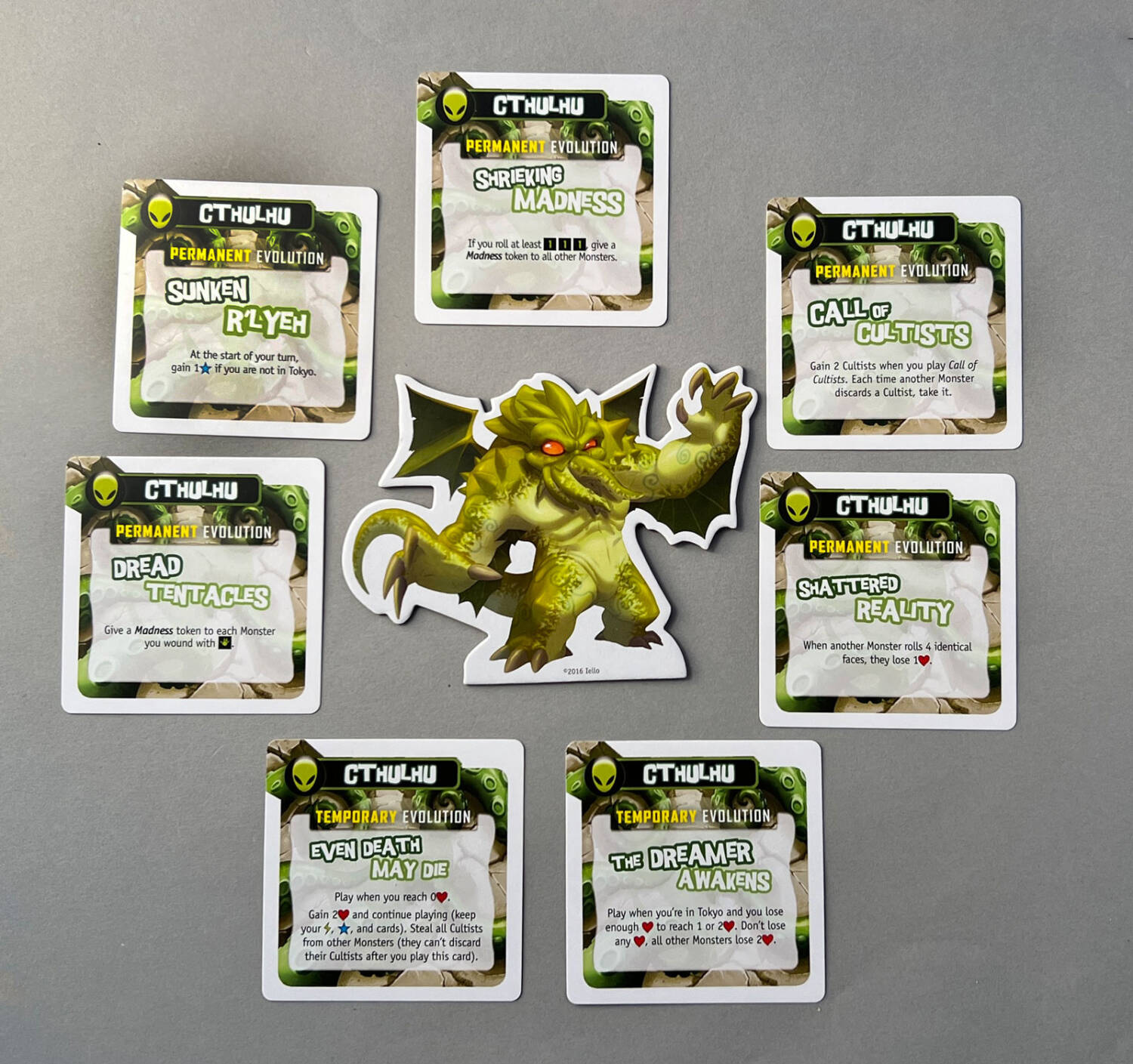The King of Tokyo Monster Packs are four monsters, each sold separately, that come with some special game-changing bits and pieces. From towers to build and conquer, to extra dice, these monsters add some spice to your King of Tokyo games.
Cthuhlu
Ph’nglui mglw’nafh Cthulhu R’lyeh wgah’nagl fhtagn

“A monster of vaguely anthropoid outline, but with an octopus-like head whose face was a mass of feelers, a scaly, rubbery-looking body, prodigious claws on hind and fore feet, and long, narrow wings behind.”
–from “The Call of Cthulhu” by H. P. Lovecraft
If you’re going to introduce new monsters to The King of Tokyo, where better to start than with The Great Old One, the cosmic entity that is Cthulhu? After all, it existed for eons before any other so-called “mythical creature” ever took to Earth.
King of Tokyo Monster Pack: Cthulhu (known as Cthulhu for the rest of this review) comes with components for both King of Tokyo and King of New York. However, I will only be covering the King of Tokyo components for this review.
Along with the standard Evolution cards, Cthulhu comes with Cultist tiles. Whenever the Cthulhu player rolls four of a kind, they can take a Cultist tile. The Cthulhu player can then discard a Cultist tile at any point to add either a Heart, or a Lightning Bolt to their roll, or give themselves an extra roll of the dice.
One Evolution card stands out, the Permanent “Dread Tentacles”. This card allows the Cthulhu player to give a Madness token to any player that damages them with Claw dice. A player with Madness tokens starts their turn by rolling dice equal to the number of Madness tokens they have. Those dice are set aside and cannot be re-rolled this turn.

A player with Madness tokens can discard them by rolling Hearts and choosing to use them to return a Madness token (at a rate of 1:1) instead of restoring their Health.
Cthulhu Thoughts
In our first game with Cthulhu, that player drew and played the “Dread Tentacles” card as his starting Evolution card. This meant for the rest of the game, the other three players found their rolls hampered by Madness tokens. This was only one of the eight Cthulhu Evolution cards, but it soured the rest of us to Cthulhu.
One thing that makes the Evolution cards work in King of Tokyo: Monster Box is that none of the cards interfere with the core game play. They grant the player a minor and/or temporary bonus that slightly augments the standard game. The Madness tokens changed the game negatively for everyone but the Cthulhu player. (Although even that player admitted he would find them annoying if he wasn’t playing as Cthulhu.)
For future games, we all agreed to remove that card from Cthulhu’s Evolution deck and leave the Madness tokens in the box.
Given that one caveat, the King of Tokyo Monster Pack: Cthulhu is a fun addition to the overall King of Tokyo monster collection. He’s made regular appearances in our games since we first tried him out.
King Kong
Ladies and Gentlemen… I give you… KONG! THE EIGHTH WONDER OF THE WORLD!

King of Tokyo Monster Pack: King Kong (known as Kong for the rest of this review) enters the fight for Tokyo with a replica of the Tokyo Tower (as well as the iconic Empire State Building for use with King of New York, a game not covered in this review). You’ll need to punch out the three sections of the Tower and then assemble them before starting the game.

With the Tokyo Tower in play, you can claim an automatic win if you possess all three pieces of the tower at the end of your turn.
To claim a part of Tokyo Tower, you’ll need to roll three 1s. The first time you do, you’ll claim the bottom section of the Tower and place it in front of you. On subsequent turns (providing someone else hasn’t rolled four 1s and taken it from you), your second set of four 1s gets you the second part of the building, etc.
The Kong Evolution card “It was Beauty killed the Beast” brings a special Beauty card into play. This card has one side just for Kong; the other side is for all other players. When this Evolution card is played, the Kong player places the Beauty card in front of themself, ‘King Kong’ side up. This gives Kong one additional die for their rolls—as long as the card remains with them.

As soon as another monster damages Kong with a Claw die, the Beauty card goes to that player, ‘Other Monsters’ side up. As long as Kong does not have the Beauty card, the Kong player cannot re-roll any Claw (damage) dice. Also, any damage they would inflict on the monster in Tokyo Bay is, instead, taken by the player who has the Beauty card. (There is no additional penalty if that player is also in Tokyo.)
King Kong Thoughts
The new way of winning the game—an immediate win whenever a single player had all three segments of the Tokyo Tower—changed how we played the game. The focus shifted from damaging whoever was in Tokyo to trying to roll three 1s. Even players who wanted to damage the Tokyo monsters defensively tried to steal away parts of the tower just to keep another player from gaining all three sections.
Personally, I’m not a fan of the Tokyo Tower element. It changes the game to just another simple dice-driven race game—exactly the type of game that puts me off of dice games.
However, the “It was Beauty Killed the Beast” card put an interesting spin on dealing out and taking damage. Without Tokyo Tower in play, I’d be willing to keep that card in play for a while.
Maybe you’ll like the change to the winning condition. Personally, I’ll be leaving it in the box and just playing King of Tokyo Monster Pack: King Kong with his Evolution and “Beauty” cards.
Anubis
The Die of Fate has been cast…and rolled!

Anubis: god of funerary rites, protector of graves, and guide to the underworld. His tomb has been desecrated and he is not happy.
As part of his displeasure, King of Tokyo Monster Pack: Anubis (known as Anubis for the rest of this review) brings with him a series of Curse cards and a 4-sided die—the Die of Fate—that will change your King of Tokyo game considerably.
Start by shuffling the 24 Curse cards to form a face-down draw pile and turn the topmost card face up. The effects of this Curse card remain in play until a roll of the Die of Fate determines another Curse card replaces it.

The Die of Fate must be rolled by all players along with the other six standard dice. It can be re-rolled if desired. With these d4s, the topmost symbol is the one in play. The four symbols are:
- Eye of Horus: Replace the current Curse card with the one from the top of the deck
- Water: No change.The permanent effect, in blue at the top of the card, remains
- Snake: Suffer the snake effect on the Curse card
- Ankh: Receive the positive bonus from the Ankh side of the current Curse card

At the start of the game, the player who will play last gets The Golden Scarab card. There are many cards that either have you give this card to other players or take the card yourself. And, of course, there are many cards that affect the player with this card in both positive and negative ways.
Anubis Thoughts
Anubis made the greatest change to the game of all four of the Monster Pack monsters. Unfortunately, I was not a fan of any of them.
The Die of Fate’s novelty wore off surprisingly quickly. Even though the Curse cards have both positive and negative effects, we hit a long streak of negatives that made us dislike the mechanic.
Unlike Cthulhu’s “Dread Tentacles” Evolution card that distributed negative effects to everyone other than Cthulhu, Anubis’ Die of Fate just made everyone’s game miserable.
King of Tokyo Monster Pack: Anubis and his Evolution cards are fine to play with. In future games, we’ll be leaving the Die of Fate to die and deflate in the box.
Cybertooth
This transforming monster goes berserk!

King of Tokyo Monster Pack: Cybertooth (known as Cybertooth for the rest of this review) comes in two distinct iterations, as his two-sided card defines: Biped Form, and Beast Form.

Cybertooth starts each game in its Biped form (with the Biped side of his two-sided card face up). Throughout the game, the Cybertooth player can exchange one Lightning Bolt die face to change to Cybertooth’s other side. Beast Form allows you to roll one of your dice an extra time, but you cannot buy any Power cards.
Why would you want to change from one form to the other? The Evolution cards. Most of them only take effect when you’re in one form or the other.

Cybertooth comes with an extra die: the Berserk die. Any player can play with this extra die whenever they roll four Claws. When this happens, the player places a Berserk token on their monster as a reminder.

They continue to roll the Berserk die as they would any other die. However, if they roll the Skull, they take one damage. (-1 Heart) If the player in Berserk mode should ever take a Heart to heal themselves, their Berserk mode ends. They remove the Berserk token from their monster and lose access to the Berserk die—until they roll four Claws again.
Cybertooth Thoughts
Of the four Monster Pack monsters, Cybertooth was the one our group liked the most. Unlike Anubis’ Die of Fate, the Berserk die was a welcome addition to everyone’s roll. As well, the earn/lose conditions of that extra die combined a sense of fairness with a bit of push-your-luck that gave it a fun edge.
By affecting all players positively, we’ll always play Cybertooth with the Berserk die. Why wouldn’t you?
As well, his Evolution cards, being divided between his two modes, give the Cybertooth player some additional choices to make throughout the game. Everyone who played as King of Tokyo Monster Pack: Cybertooth liked that extra touch to the character. Given how well received this mechanic was, we were disappointed that the other three monsters in the King of Tokyo Monster Pack series went the opposite direction.















Add Comment